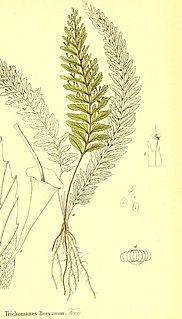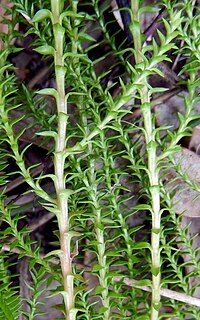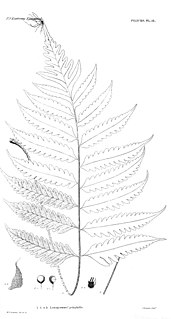
Microsorum is a genus of ferns in the family Polypodiaceae, subfamily Microsoroideae, according to the Pteridophyte Phylogeny Group classification of 2016 (PPG I). The species are tropical. Like most ferns, they grow from rhizomes, rather than roots. The genus name is often misspelled "Microsorium" or "Microsoreum". It includes some species that are lithophytic rheophytes.

Saccoloma is a fern genus in family Saccolomataceae. It is the only genus in the family in the Pteridophyte Phylogeny Group classification of 2016, but further investigation is needed. It is pantropical and its species are found in wet, shaded forest areas. Saccoloma species are characterized by an omega-shaped (Ω) vascular bundle in the cross-sections of their petioles. The common name soralpouch fern is used for Saccoloma.

Trichomanes is a genus of ferns in the family Hymenophyllaceae, termed bristle ferns. The circumscription of the genus is disputed. All ferns in the genus are filmy ferns, with leaf tissue typically 2 cells thick. This thinness generally necessitates a permanently humid habitat, and makes the fronds somewhat translucent. Because of this membrane-like frond tissue, the plant is prone to drying out. “Filmy ferns” in the taxa Hymenophyllaceae grow in constantly wet environments. Many are found in cloud forests such as “Choco” in Columbia. There are also members of the taxa that can grow submersed in water.

Didymoglossum melanopus is a species of fern in the family Hymenophyllaceae. It is endemic to Ecuador.

Cephalomanes is a fern genus in the family Hymenophyllaceae. The genus is accepted in the Pteridophyte Phylogeny Group classification of 2016 but not by other sources, which sink it into a broadly defined Trichomanes.

Matonia is a genus of fern, named for English botanist William George Maton. It is native to Thailand, Malesia and New Guinea.

Callistopteris is a fern genus in the family Hymenophyllaceae. The genus is accepted in the Pteridophyte Phylogeny Group classification of 2016 but not by some other sources, which sink it into a broadly defined Trichomanes.

Polyphlebium is a fern genus in the family Hymenophyllaceae. The genus is accepted in the Pteridophyte Phylogeny Group classification of 2016 but not by some other sources.

Vandenboschia is a fern genus in the family Hymenophyllaceae. The genus is accepted in the Pteridophyte Phylogeny Group classification of 2016 but not by some other sources.

Abrodictyum is a fern genus in the family Hymenophyllaceae. The genus is accepted in the Pteridophyte Phylogeny Group classification of 2016 but not by some other sources, which sink it into a broadly defined Trichomanes.

Cephalomanes atrovirens is a species of fern in the family Hymenophyllaceae. The genus Cephalomanes is accepted in the Pteridophyte Phylogeny Group classification of 2016, but not by some other sources. As of October 2019, Plants of the World Online sank the genus into a broadly defined Trichomanes, while treating the subtaxa of this species as the separate species Trichomanes acrosorum, Trichomanes atrovirens, Trichomanes boryanum and Trichomanes kingii.

Lateristachys is a genus of lycophytes in the family Lycopodiaceae. In the Pteridophyte Phylogeny Group classification of 2016, it is placed in the subfamily Lycopodielloideae. Some sources do not recognize the genus, sinking it into Lycopodiella. Lateristachys species are native to the Philippines, Australia and New Zealand.
Syngramma is a genus of ferns in the subfamily Pteridoideae of the family Pteridaceae. Species are native to south-east tropical Asia and the Pacific.

Taenitis is a genus of ferns in the subfamily Pteridoideae of the family Pteridaceae. Species are native to south-east tropical Asia, Australia and the Pacific.
Vaginularia is a genus of ferns in the subfamily Vittarioideae of the family Pteridaceae in the Pteridophyte Phylogeny Group classification of 2016. Other sources sink the genus into Monogramma, a genus not recognized in PPG I.
Arthrobotrya is a genus of ferns in the family Dryopteridaceae, subfamily Elaphoglossoideae, in the Pteridophyte Phylogeny Group classification of 2016. The genus is native to Australia and New Zealand.
Pleocnemia is a genus of ferns in the family Dryopteridaceae, subfamily Elaphoglossoideae, in the Pteridophyte Phylogeny Group classification of 2016.

Lomagramma is a genus of ferns in the family Dryopteridaceae, subfamily Elaphoglossoideae, in the Pteridophyte Phylogeny Group classification of 2016.
Polypodiopteris is a genus of ferns in the family Polypodiaceae, subfamily Drynarioideae, according to the Pteridophyte Phylogeny Group classification of 2016 (PPG I).

Dendroconche is a genus of ferns in the family Polypodiaceae, subfamily Microsoroideae, erected in 2019. As of February 2020, the genus was not accepted by some sources.














